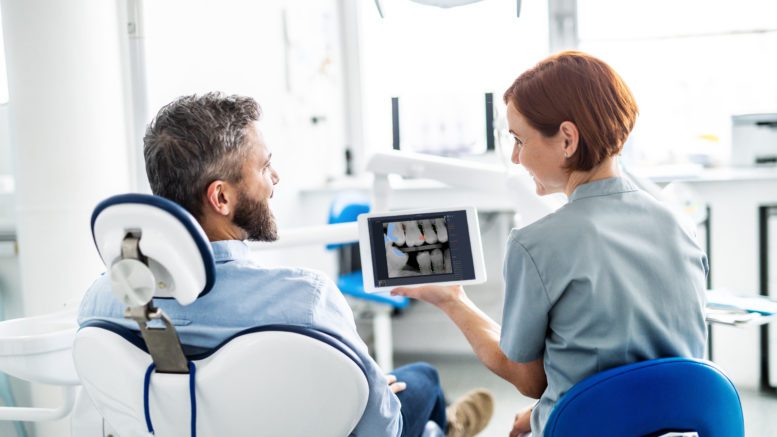
Alignment. It’s one of those goals that everyone wants, but can be very difficult to achieve.
“The key is having the right people, products and processes in place,” said Dee Fischer, one of the country’s leading DSO consultants and the founder of Fischer’s Professional Group. Fischer works with groups from two to 280 locations to help them create alignment, develop processes, and build a strong culture to support practice growth and success.
She’s implementing artificial intelligence solutions like Overjet into practices to:
- Create clinical alignment around standards of care
- Develop the confidence of new providers
- Increase patient education and case acceptance
- Improve workplace culture, leading to less turnover
- Overcome burnout and fatigue
“Leadership starts with alignment,” Fischer said. “You need to have clinical alignment, and you need to have alignment from the front office to the back office. Everyone needs to know what is your standard of care, how are you going to treat different conditions. That’s where AI makes it so much easier.”
Developing Clinical Alignment with AI
Show the same X-ray to two different dentists, and you may receive two different diagnoses. Providers can interpret X-rays differently based on their training and treatment philosophy.
AI software like Overjet trains on millions of X-rays to provide an objective analysis of tooth structures and pathologies. It provides real-time radiograph analysis to doctors and hygienists, drawing their eye to areas of concern. Overjet is the only AI platform FDA-cleared for both decay detection and quantifying bone loss.
Now practices can set consistent standards of care for periodontal and restorative benchmarks, and have an objective source of information to review in determining treatment.
“My doctors love it,” said Dee Fischer. “It takes out the guesswork of what the patient needs. I think AI is going to improve healthcare across the U.S.”
Develop the Confidence of New Providers with AI
Artificial intelligence software is directional, not diagnostic. It helps providers know where to take a deeper look and provides data-driven insights to aid in diagnosis and treatment planning.
That can be especially helpful for younger providers who may lack experience and confidence. During the pandemic, dental students did not have as many opportunities for hands-on learning or to treatment plan and perform as many clinical procedures.
AI-driven radiograph analysis helps them feel confident they are not missing potential pathologies, and gives them a point of reference to start a dialogue with their colleagues about the findings and the best way to provide treatment.
Increase Patient Education and Case Acceptance
AI not only helps ensure providers are seeing the same findings on the radiographs, but also helps patients visualize what is happening with their oral health.
Most patients don’t know how to read traditional X-rays. By highlighting the areas of concern, outlining cavities, and showing the bone level measurements right on the X-ray, people understand what they’re looking at.
It increases their confidence in the diagnosis, and increases case acceptance – including same-day treatment.
The front desk team plays a crucial role in aligning patient and practice expectations. The scheduler can start the process by letting the patient know what’s going to happen when the patient comes into the practice by saying, “We’re going to do the exam and take the necessary X-rays, and if we can treat you today, we will. We know your time is valuable.”
Improve Workplace Culture
AI also improves workplace culture by helping to build respect among the providers. For example, hygienists feel more supported when they have Overjet’s objective bone loss measurements to show the doctor and support their recommendation of scaling and root planing. It removes the doubt over whether treatment is warranted.
“I’ve seen practices where there’s friction between hygienists and providers over whether perio treatment is necessary,” said Dee Fischer. “AI provides validation. From what I’ve seen, AI’s built respect among providers.”
Dr. Ankoo Raina, the Chief Dental Officer at Jefferson Dental & Orthodontics, said implementing Overjet has helped them hire and retain hygienists.
“Hygienists are very happy to have this tool to show patients the bone level measurements, and having that support a perio diagnosis,” said Dr. Raina. “Having Overjet give objective data that quantifies it, that eliminates conflicts between providers, too.”
When people feel respected and valued, they are more likely to stay. That reduces staff turnover.
Overcome Burnout and Fatigue
Many providers and team members are exhausted and suffering from burnout, and that can make it harder to focus. When it comes to reading radiographs, lack of focus can lead to pathologies being missed or misdiagnosed.
AI’s computer algorithms never get tired or need a break. They return the same consistent findings every time. That provides a safety net for providers and helps to ensure they don’t miss potential oral health problems.
It provides another level of support for the clinical team members, making their jobs easier and helping them be able to consistently provide a high quality of care.
Consistent Standards of Care
Overjet recently conducted a survey of why DSO providers were implementing AI into their radiograph workflow.
The top reason was to create consistency and standardization of care, followed closely by helping clinicians with their diagnostic workflow. The third most popular answer was increasing case acceptance and improving patient communication.
